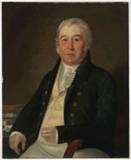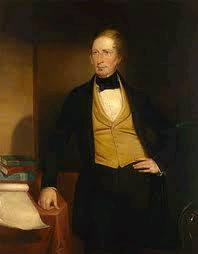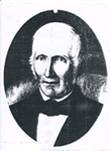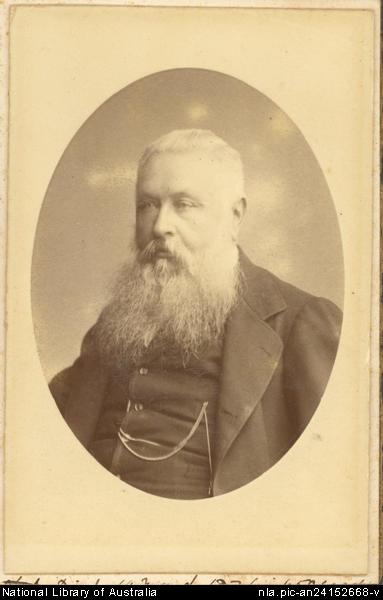 |
 |  |  |  |  |  |  | | | ______________________
The Scenic Hills from Denham Court in 1884

Pencil sketch by Harold Brees (Source: Mills & Pile, Terms and Conditions of Sale of the Estate, 1884). The views from Denham Court along Campbelltown Road remain much the same today but are at risk from rampant development.
____________________________
Early Owners of Varro Ville in the 19th century

Dr. Robert Townson
(painting in the Mitchell Library, Sydney), original owner of Varro
Ville from 1809 to 1827.
Doctor of Civil Laws and gentleman
scientist, he was the most educated man in the NSW colony when he arrived
in 1807, speaking five languages and author of a number of books
(depicted on the table in the painting above). He made Varro Ville a
model of agriculture with a much admired vineyard - regarded as second
only to Gregory Blaxland's at Brush Farm at the time.
___________________

Austrialian Explorer, Captain Charles Sturt (painting in the National Gallery, Adelaide), owner of Varro Ville from 1837 - 1839.
He made Varro Ville a model of
water conservation with altered water courses and water holes in every
paddock. He kept nineteen local
families in water during the terrible drought of 1838, which earned him
free pass by bushrangers on the Campbelltown Road to Liverpool
and Sydney.
____________________

James Raymond, NSW's
first Postmaster General, owner of Varro Ville 1839 - 1851, sold after
his death by his sons in 1858.
James Raymond created a world first when
he introduced prepaid postage to the colony ahead of England. He used the property as
his country retreat and bred racehorses there.
_____________________

Judge Alfred Cheeke
(picture from the National Library of Australia), owner of Varro Ville 1859 - 1876.
Cheeke built the current
(third) house on the property.He was a judge in the Supreme Court of NSW where he presided at the trial of Fenian H.
J. O' Farrell (a relative we wonder?) who had attempted to assassinate the visiting Duke of
Edinburgh in 1868. Cheeke bred and and trained horses at Varro Ville, including 'Clove' who won the first AJC Derby recorded
in the Turf Register in 1865.
| |
|
|
 |
|
 | | 
 |
|
The Catholic
Cemeteries Board wants land rezoned for a large commercial cemetery in the heart
of the Scenic Hills
Community and Landowners 'Blindsided'
On
Wednesday the 28th August 2013, the Catholic Cemeteries Board,
representing the Catholic Metropolitan Cemeteries Trust (a service of the Sydney Archdiocese), held a media
conference to launch their proposal to have 113 hectares of land in the
heart of Scenic Hills (an environmental protection area) rezoned for a commercial cemetery. The land in
question is the most historic piece of land in the Scenic Hills being
the core of the original c.1810 Varro Ville estate.The proposal was
negotiated in secrecy and launched with an 'invitation-only' news event
for the local media and local Catholic community leaders - notably the
Board of the Catholic Club, the Bishop of Wollongong & MP Bryan
Doyle (who is NOT the MP for this part of the Scenic Hills) whose role seems to have been to 'spruik' the project to the media. The owners
of Varro Ville House, located in the middle of the proposed cemetery,
and the State MP for the area, Dr Andrew McDonald (Macquarie Fields)
were not invited.
Channel 10 News's John Hill was quick to pick up the story, 3rd September.
Read (click on link):
Macarthur Advertiser, 3/9/13: 136,0000-plot cemetery proposed for Campbelltown's Scenic Hills
Macarthur Advertiser 29/8/13: Proposed cemetery could 'destroy' Scenic Hills
'Disneyland for the Dead'
Following the media event, the owners of Varro Ville House were given a briefing and were horrified to see how actual heritage
on the former estate - old vineyard terracing dating to the early
1800s, a water conservation system of dams & watercourses
established by the explorer Captain Charles Sturt in the 1830s, and the
landscape park for Varro Ville House c. 1859 - which up until now have
been preserved by the Environmental Protection zoning of the Scenic
Hills, would be largely destroyed...displaced by grave sites and modern
day parklands: a 'Disneyland for the Dead'.
Read (click on link):
Macarthur Chronicle article: Cemetery Proposal
Macarthur Chronicle 4/9/13: Varroville House owner oposes neighbouring 136,000 gravesite plan.
The end of the Scenic Hills
For this to happen, Campbelltown Council will have to rezone the area to allow a
commercial development (currently prohibited) to be made permissable. If it does, it will set a precedent that will result in the loss
of the remaining Scenic Hills Protection area.
What will be lost?
1.One of NSW's finest heritage properties (Varro Ville) associated with people important to the early establishment of the NSW colony (see opposite):
- Dr Robert Townson (owner 1809-1827)
- Explorer Captain Charles Sturt (owner 1837-1839)
- NSW's first Postmaster-General James Raymond (owner 1839-1851)
- Supreme Court Judge Alfred Cheeke (owner 1859-1876)
- William Weaver (Colonial Architect 1854-1856)
2. A rare surviving colonial landscape.
3. An important environmental green space known as 'the lungs of
Campbelltown'.
4. Campbelltown's scenic backdrop - separating it from Camden & Liverpool.
Why will Varro Ville House be lost?
The land in question is the estate core for Varro Ville House.
- Varro Ville House will lose its context - that is, its agricultural
and estate features that allow it to be effectively interpreted as a house at the heart of an early colonial estate.
- It will lose its architectural intention as a 'house in landscape'.
- According to
property experts, the loss of context and its replacement with a
cemetery will reduce the value of the house by at least half - making its ongoing
maintenance financially unviable...no matter who owns it.
- If the owners are forced to sell, it is unlikely that the house and its outbuildings will survive. The Catholic
Cemeteries Trust has told the owners that it does not want to put
any money into heritage unless it is forced to. It has no use for these
buildings making their future grim. The Trust's public claims about preserving heritage can no longer be believed!
Why will this be tragic?
Varro Ville House is
the third house on the estate - designed and built by former colonial architect William Weaver as a 'house in landscape' c.1859. It is listed on the Register of the
National Estate, the State Heritage Register, the Campbelltown Local
Environment Plan, and classified by the National Trust. It is surrounded by 800 acres of its original 1000-acre grant
to Dr Robert Townson (see opposite) in 1810, which has been protected
since 1973 by its inclusion in the Scenic Hills Environmental Protection
zone. The adjoining Scenic Hills Riding Ranch was originally part of
the estate.
In a report
commissioned in 2000 by the NSW Heritage Council, the authors said of Varro Ville: "[it] is one of the few estates remaining in
the Campbelltown area where the form of the original grant and the
former agricultural use of the estate is still appreciable to any great
extent." (Colonial Landscapes of the Cumberland Plain and Camden, NSW, prepared by Colleen Morris &Geoffrey Britton for the National Trust of Australia (NSW) August 2000).
How did the house become detached from its surrounding land?
In
the early 1970s, before the Scenic Protection zoning was in
place, owners Morris and Cherry Jackaman subdivided the house onto 3 hectares,
separating it from its agricultural and estate features located in the
surrounding land - including the vineyards, dams, its
original 19th driveways to Campbelltown and St Andrews Roads, and its
early outbuildings dating to the early 1800s. Attempts to develop the surrounding land were prevented by the new Scenic Protection zoning.
What has happened since to protect the buildings and land?
Only
the house lot was placed on the State Heritage Register. Cherry Jackaman, whose family owned the remaining land until 2007, resisted attempts by the
NSW Heritage Office to extend the state listing to its outbuildings and
other important agricultural features on her family's land.
By
1990, the house had fallen into disrepair and was given to the National
Trust by Mrs Jackaman who had not lived there for a decade. The
National Trust was unable to find the funds to restore it and sold it
with strict conditions for its restoration and maintenance. It has had
three owners since 1992 and has gradually been restored to its former
glory.
This has not included the outbuildings which, since 1990 have continued
to decline under separate ownership. Successive owners of the house
have tried to acquire the outbuildings and more land, but without
success.
In
2007, the Jackaman family sold the surrounding land (and outbuildings)
to land developers the Cornish Group in a closed auction, driving the price of the land further out of reach. The rare
early outbuildings have suffered one of their worst periods of neglect during
this time and are now at risk of being lost. They are associated with
early owners of the property (see photos and text on the left hand side
of this page).
In
2007 when the Cornish Group proposed a Business Park (Industrial
Estate) for the land, (including the Riding Ranch) the NSW Heritage
Office wrote to the selling agent advising that the land adjoined a State listed property whose curtilage was still being investigated. It then wrote to Campbelltown City Council urging it to keep the
Environmental Protection (Scenic) zoning in place. The Heritage Office indicated that it would be investigating an epanded curtilage for the House. Nothing has happened
since. In 2007 the former NSW Government reduced the powers of the
Heritage Council leaving Varro Ville House and the surrounding land in
limbo. The situation for heritage has deteriorated under the Baird Government causing protest around NSW. Until this is resolved, the best protection remains the retention of
the current planning controls that prohibit commercial developments that are unsympathetic to the objectives of the zoning.
What else will be lost?
[This page is still under construction]
 |
|











